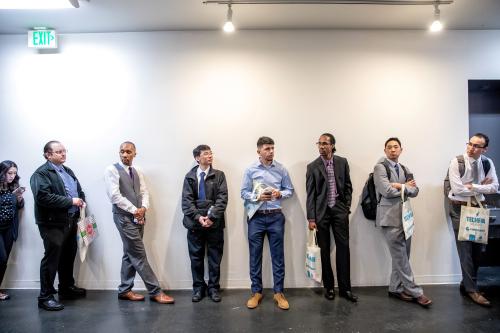This article originally appeared in the Guardian on August 21, 2019, as part of the Guardian series on Broken Capitalism.
Is contemporary capitalism compatible with liberal democracy? The glib answer, though not wrong, is that it had better be. There are no known examples of fully socialized economies with a liberal democratic regime. The more considered answer is that it can be, but only with the public policies that make it so.
The relationship between liberal democracy and capitalism changes over time, as do the policies needed to make them mutually supportive. Not for the first time, changes in the structure of capitalism have lately moved faster than the policies required to domesticate them. Liberal democratic governments are scrambling to catch up.
Ever since Aristotle examined the relationship between class structure and regimes of government, political scientists have understood that a strong middle class is the foundation of stable constitutional governance. The reason is straightforward: in societies divided into the rich few and the many poor, class warfare is inevitable. The rich will use the state to defend what they have; the poor, to gain a bigger share. Sometimes this will be through majoritarian democracy, but is often led by a strongman claiming to act in the people’s name. By contrast to either of these ambitions, the middle class tends more to prize the rule of law and to seek incremental rather than radical change.
Through much of human history, class structure was a product of chance and force, not policy. Because economic growth as we know it today existed neither in theory nor reality, economies were understood as zero-sum games. Political communities gained through plunder and conquest (or imperial tribute); economic classes gained through redistribution. It is only during the past three centuries that long-term, secular economic growth, from which in principle all can gain, was conceptualized and realized as part of humankind’s lived experience.
There was nothing natural or automatic about this process. The vibrant markets on which growth depends are systems of rules backed by public power as well as social norms. Wise policies are needed to ensure that the fruits of growth are widely shared. When these conditions are satisfied, market economies tend to generate not only broad improvements in living standards but also growing middle classes that the poor can hope to enter. Market-driven economic growth tends therefore to support constitutional governance in its modern form, combining elements of majoritarian democracy with protected individual rights and liberties.
The expectation of economic growth from which all can benefit is a centerpiece of modern politics. When hope and reality diverge, the losers are bound to resist, and sympathetic winners often join their cause.
The Industrial Revolution sparked more than a century of reform, with the aim of taming capitalism’s excesses and cyclical instability. The failure of these efforts during the Great Depression led to the collapse of liberal democracies throughout much of the West and to the rise of anti-democratic regimes and ideologies on the Left and the Right. Whatever their place on the ideological spectrum, these forces damaged not only democracy, but also markets and individual liberty.
It was not until the end of World War Two that policy makers successfully deployed industrial capitalism in support of liberal democracy. Strong trade unions helped balance the interests of labor and capital. Social programs helped meet basic needs and provide security for sick, unemployed, and elderly citizens. Counter-cyclical policies reduced the severity of economic downturns. International institutions stabilized currencies and trade.
These post-war policies laid the foundations for decades of economic growth and rising standards of living. Confidence in governments and markets grew. The fall of the Berlin War and collapse of the Soviet Union put this confidence on steroids. In much of the West, left-wing parties made their peace with markets and entered an era of “Third Way” politics. The post-war order seemed to represent a permanent, mutually beneficial settlement of the tension between markets and liberal democratic politics.
But beneath the tranquil surface of liberal democracies, disruptive pressures were building. As the industrial era gave way to the information age, post-war policies came under pressure. Manufacturing employment–a leading source of stable, well-paying jobs–lost ground, first relatively, then absolutely. The rise of the knowledge-based economy created sharper disparities—between more and less well-educated workers, and also between regions.
Globalization put additional pressure on the post-war order. With the increased mobility of capital, corporations shifted production from high-wage to low-wage jurisdictions, between regions and also between nations. The collapse of the Soviet Union freed tens of millions of poorly paid workers to enter the global marketplace. As production dispersed, corporations became less rooted in and less responsive to the concerns of local communities. The interests of their shareholders often trumped loyalty to their country of origin. These disruptive forces intensified when China entered the WTO in 2001. Economic inequality increased and social mobility slowed, especially in the United States.
Still, the post-war order seemed viable—until the Great Recession struck. From 2007, output fell, unemployment surged, and the global financial system nearly collapsed. Some liberal democracies deployed counter-cyclical policies. Others resorted to austerity. Fiscal constraints, real or imagined, forced central banks to adopt unprecedented strategies that staved off disaster but failed to stimulate a strong recovery. In economies with strong protections for incumbent workers, many young adults found themselves on the outside of the economy, looking in.
As growth has slowed and fewer citizens share in the gains from growth, support for liberal democracy has weakened. The example of China has convinced some autocrats that the West’s model is no longer the only game in town: it seems that they can enjoy the benefits of rapid economic growth without liberalizing their politics or abandoning control over the commanding heights of their economies.
Within the West, rising populist movements are rejecting the liberal elements of liberal democracy in favor of systems that allow popular majorities to get their way, even at the cost of individual and minority rights. The institutions that defend liberalism—independent constitutional courts, a free press, and robust civil society—are under attack.
The political challenge is clear. As the industrial economy has given way to the information economy, the post-war reconciliation of markets and liberal democracy that fostered social mobility and a strong middle class has become obsolete. We need a new strategy for a new era. This is a challenge not only to our political system, but to our political imagination.
The central aim of public policy now is to ensure that contemporary capitalism strengthens rather than undermines liberal democracy. The components of this new program are tolerably clear, even though specific policies remain contested. Among them:
- Completing secondary education and receiving at least some post-secondary training is now economically essential. To make this necessity a reality, public policy will have to do more—from pre-school to college–to break the link between family background and educational attainment.
- Public policy should do more to resist growing regional disparities. Traditional regional subsidies are the equivalent of blood transfusions, keeping patients alive without restoring them to health. Instead, governments should ensure that all regions have the building blocks of economic growth—education, transportation, finance, information, and infrastructure.
- In most advanced societies, economic concentration is increasing, limiting competition, innovation, and entrepreneurial opportunities. Europe has taken the lead in resisting these negative trends, and other market economies should follow suit. Consumer prices are no longer an adequate guide to anti-trust policies, if they ever were.
- Wages for lower-skilled occupations in advanced economies will be limited by wages for these jobs in less-developed societies. Higher productivity helps, but not enough. Public policy must step in, with higher minimum wages, increased wage subsidies, and universal opportunities for workers to share in rising business productivity and profits.
- The excesses of globalization must also be reined in. Capital mobility should be limited when it imposes intolerable costs on jobs, wages, and social stability in advanced economies. Trade rules should not give advantages to state-controlled economies at the expense of market economies.
It is reasonable to worry that liberal democratic governments lack the capacity to make the kinds of sweeping changes that secured economic growth and political stability in the 1940s and 1950s. In most liberal democracies today, deep divisions may preclude the bold policy initiatives we need.
Political reform is therefore required along two tracks—changing institutional structures to make effective government more possible in divided societies; and taking on directly the social divisions that have polarized democratic politics and sparked the populist surge.
On the first track lie reforms to ensure neutral procedures for creating electoral districts; new measures to reduce the impact of money on political outcomes; and rules to increase incentives for elected officials to cooperate across partisan and ideological divides. On the second, reforms to restrict divisive media practices and rally civil organizations to build bridges among partisans in local communities. For example, laws governing social media platforms could be amended to hold them more responsible for messages promoting hatred, violence, and illegality, and foundations could invest aggressively in organizations promoting civil dialogues among citizens with divergent policy views and ideological commitments.
This menu of economic and political reforms is daunting. If the present offers little consolation, history is more encouraging. Well-established liberal democracies have repeatedly demonstrated their capacity for reinvention. Although at present the gap between the need for effective leaders and the supply of such leaders is at a cyclical peak, we can reasonably hope that clear-sighted politicians with a gift for public explanation will emerge as they have in past crises, and that they will have the ability to inspire their peoples to undertake the tasks their future requires.







Commentary
Op-edYes, contemporary capitalism can be compatible with liberal democracy
September 11, 2019